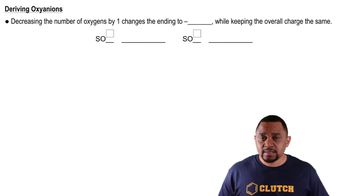Here are the essential concepts you must grasp in order to answer the question correctly.
Ionic Compounds
Ionic compounds are formed when atoms transfer electrons, resulting in the formation of positively charged cations and negatively charged anions. These oppositely charged ions attract each other, creating a stable compound. Understanding the structure and properties of ionic compounds is essential for identifying and naming them correctly.
Recommended video:
Polyatomic Ions
Polyatomic ions are ions that consist of two or more atoms bonded together, carrying a net charge. Common examples include hydroxide (OH⁻) and sulfate (SO₄²⁻). Recognizing these ions is crucial for naming ionic compounds that contain them, as they often have specific naming conventions that differ from monatomic ions.
Recommended video:
Polyatomic Ion Variations
Nomenclature of Ionic Compounds
The nomenclature of ionic compounds involves systematic rules for naming compounds based on their constituent ions. For compounds containing polyatomic ions, the name of the polyatomic ion is used directly in the compound's name. Understanding these rules helps in accurately identifying and naming compounds like Ba(OH)₂, which is called barium hydroxide.
Recommended video:

 Verified step by step guidance
Verified step by step guidance


